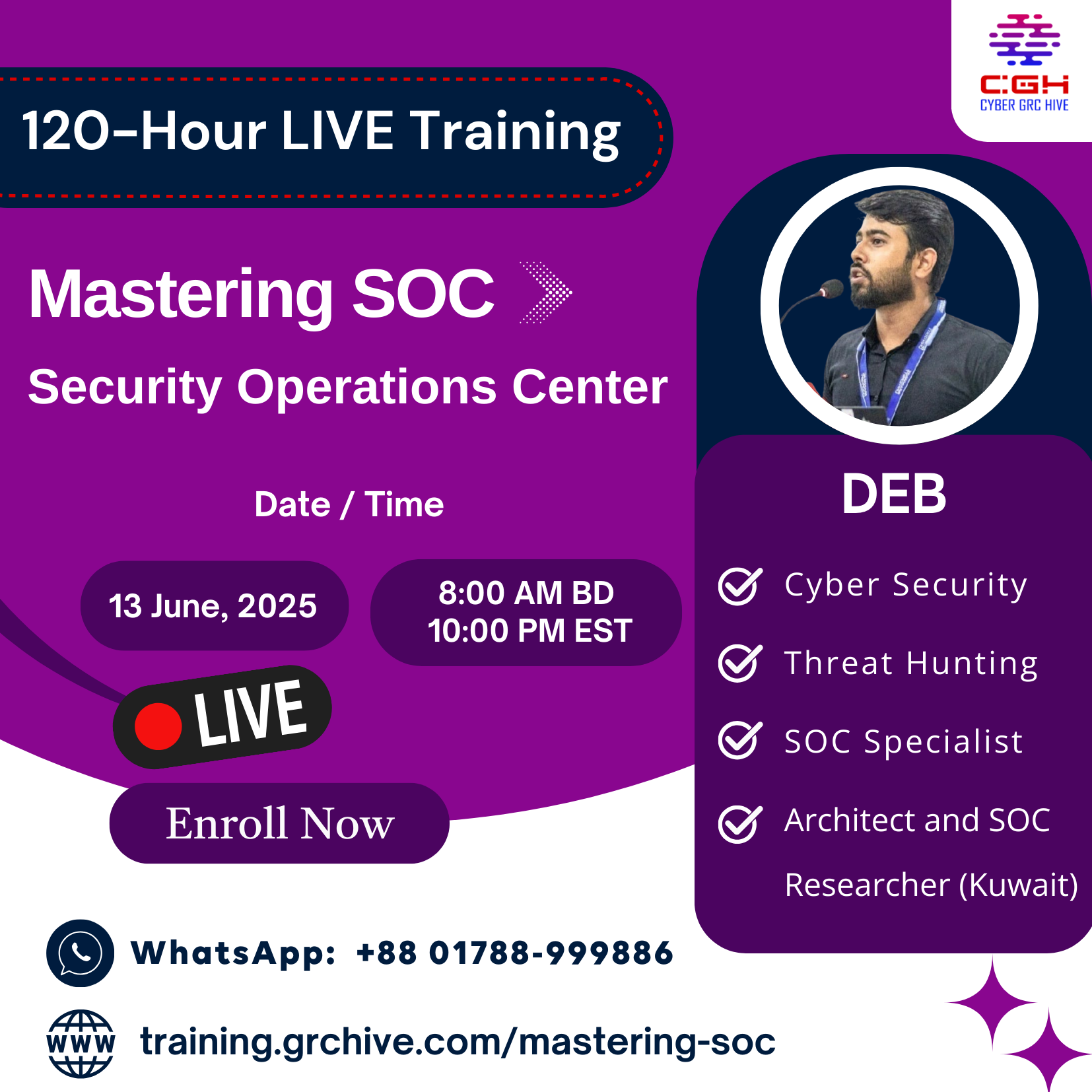Mastering SOC: Security Operation Center
120+ Hours Live Online Class
🚀 Mastering SOC – Largest Security Operations Center (SOC) Course!
A complete 120-hour course over 4 months, where you’ll learn from scratch how to become a skilled SOC Analyst.
🛡️ Hands-on practical training using real-life tools and an industry-standard syllabus.
👨💻 Whether you’re from an IT or Non-IT background, you can start easily.
🎓 At the end of the course, you’ll receive a certificate, job-ready skills, and access to a supportive community.
Course Overview and Benefits
Most Asked Questions →
You’ll learn SOC fundamentals, threat detection, incident response, and how to use tools like SIEM to monitor and secure systems effectively.
Basic IT or cybersecurity knowledge is helpful, but the course starts with foundational skills, making it suitable for beginners and intermediates.
The course spans 120 hours, typically spread over weeks or months, depending on your pace and schedule.
Yes, the course includes practical labs to simulate real-world SOC scenarios, helping you apply skills like threat analysis and response.
Absolutely, it equips you with job-ready skills and knowledge for roles like SOC analyst, including certification prep and operational expertise.
Course Modules
Phase 1: Fundamentals
Week 1: Networking Essentials
What You’ll Learn:
- Understand the OSI Model and its layers.
- Dive into TCP/IP architecture, IP addressing, and subnetting.
- Explore key protocols like HTTP, DNS, FTP, and SMTP.
- Learn how to capture and analyze network traffic using Wireshark.
Hands-On Activities:
- Install Wireshark and capture live network traffic.
- Analyze HTTP and DNS packets to understand their structure.
- Practice subnetting exercises to divide IP ranges efficiently.
Tools You’ll Use:
- Free & Open Source: Wireshark, Nmap, tcpdump.
- Proprietary: SolarWinds Network Performance Monitor.
Week 2: Networking Advanced Fundamentals
What You’ll Learn:
- Configure VLANs for network segmentation.
- Set up VPNs for secure remote access.
- Understand routing protocols like OSPF and BGP.
- Explore NAT and firewall configurations.
- Learn about wireless security (WPA2, WEP) and best practices.
Hands-On Activities:
- Use Cisco Packet Tracer or GNS3 to configure VLANs and routing.
- Set up a VPN using OpenVPN.
- Configure a firewall using pfSense.
Tools You’ll Use:
- Free & Open Source: OpenVPN, pfSense, VyOS.
- Proprietary: Cisco Packet Tracer, FortiGate.
Week 3: Linux Fundamentals
What You’ll Learn:
- Navigate the Linux directory structure (/bin, /etc, /var, etc.).
- Master essential commands like ls, cd, grep, and awk.
- Manage file permissions and processes.
- Write basic Bash scripts to automate tasks.
Hands-On Activities:
- Install Ubuntu or CentOS in a virtual machine.
- Write a Bash script to automate file backups.
- Practice managing file permissions and processes.
Tools You’ll Use:
- Free & Open Source: Ubuntu, CentOS, Fedora, Nano/Vi.
- Proprietary: Red Hat Enterprise Linux (RHEL), SUSE Linux.
Week 4: Linux System Administration
What You’ll Learn:
- Manage users and groups on a Linux system.
- Work with logs (Syslog, Journald) and configure log rotation.
- Use Cron to schedule tasks.
- Automate system administration tasks using Ansible.
Hands-On Activities:
- Secure a Linux server by disabling root login and enabling SSH key authentication.
- Automate log rotation using Cron.
- Use Ansible to deploy a web server
Tools You’ll Use:
- Free & Open Source: Cockpit, Webmin, Ansible.
- Proprietary: Red Hat Satellite, Puppet Enterprise.
Week 5: Windows Server Basics
What You’ll Learn:
- Explore Windows file systems (NTFS, ReFS).
- Analyze logs using Event Viewer.
- Get an overview of Active Directory and domain controllers.
- Write basic PowerShell scripts.
Hands-On Activities:
- Install Windows Server in a virtual machine.
- Configure Active Directory and create user accounts.
- Analyze logs using Event Viewer.
Tools You’ll Use:
- Proprietary: Microsoft Windows Server, Active Directory.
Phase 2: Core Defensive Security
Week 6-7: Windows System Administration
What You’ll Learn:
- Configure Group Policy Objects (GPOs) in Active Directory.
- Understand LDAP and Kerberos authentication.
- Write advanced PowerShell scripts for automation.
- Integrate Azure AD with on-premise Active Directory.
Hands-On Activities:
- Configure GPOs to enforce password policies.
- Write PowerShell scripts to manage users and roles.
- Integrate on-premise AD with Azure AD.
Tools You’ll Use:
- Free & Open Source: PowerShell Core.
- Proprietary: Azure Active Directory, Microsoft Endpoint Manager
Week 8: Security Fundamentals
What You’ll Learn:
- Understand the CIA Triad (Confidentiality, Integrity, Availability).
- Explore common threats like phishing, malware, and DDoS.
- Learn about SOC functions and security tools (SIEM, EDR).
Hands-On Activities:
- Simulate a phishing attack and analyze its impact.
- Use OpenVAS to scan for vulnerabilities.
Tools You’ll Use:
- Free & Open Source: OpenVAS, Metasploit Community Edition.
- Proprietary: Qualys, Nessus Pro.
Week 9: IDS/IPS Basics
What You’ll Learn:
- Understand Intrusion Detection and Prevention Systems (IDS/IPS).
- Configure Snort or Suricata for intrusion detection.
Hands-On Activities:
- Install and configure Snort for intrusion detection.
- Analyze alerts generated by Snort.
Tools You’ll Use:
- Free & Open Source: Snort, Suricata.
- Proprietary: Palo Alto Threat Prevention, Cisco Firepower.
Week 10: Threat Detection & SIEM Basics
What You’ll Learn:
- Understand SIEM (Security Information and Event Management).
- Write correlation rules to detect threats.
Hands-On Activities:
- Set up Wazuh or ELK Stack.
- Write correlation rules to detect suspicious activity.
Tools You’ll Use:
- Free & Open Source: Wazuh, Graylog, ELK Stack.
- Proprietary: Splunk, QRadar
Phase 3: Advanced Security Operations
Week 14-15: Threat Intelligence
What You’ll Learn:
- Gather Open Source Intelligence (OSINT).
- Use MISP and Shodan for threat intelligence and DFIR.
Hands-On Activities:
- Use Shodan to identify exposed devices.
- Analyze threat feeds in MISP
Tools You’ll Use:
- o Free & Open Source: MISP, Shodan.
- Proprietary: Recorded Future, ThreatConnect.
Phase 4: Capstone Projects & Placement Preparation
Week 21-22: Capstone Projects
What You’ll Learn:
- Build a SOC environment from scratch.
- Simulate Advanced Persistent Threat (APT) attacks and respond.
Hands-On Activities:
- Use VirtualBox and Docker to create a SOC lab.
- Simulate an APT attack and analyze logs using SIEM.
Tools You’ll Use:
- Free & Open Source: VirtualBox, Vagrant, Docker, Kubernetes.
- Proprietary: VMware Workstation Pro.
Week 23: Mock SOC Operations
What You’ll Learn:
- Simulate real-world SOC analyst operations.
- Detect and respond to incidents.
Hands-On Activities:
- Use TheHive to manage incidents.
- Analyze logs and respond to simulated threats
Tools You’ll Use:
- Free & Open Source: VirtualBox, TheHive.
- Proprietary: Splunk, QRadar.
Week 24: Placement Preparation
What You’ll Learn:
- Build a cybersecurity-focused resume.
- Prepare for SOC-specific interview questions.
Hands-On Activities:
- Participate in mock interviews.
- Prepare and refine your resume.
Course Highlights

Training Duration
4+ Months 120+ Hour
Class Attendance Required
90%

Weekly
2-3 days
Who Can do this
Everyone
Training Mode: Online

LIVE Class Duration
2 Hours (Including Live labs/projects)
Trainer
Industry Expert
Lectures
Theoretical concepts explained with real-world examples.
Hands-on Labs
Practical sessions using industry-standard tools.
Case Studies
Analysis of real-world cybersecurity incidents.
Projects
Simulated SOC operations to apply knowledge in a controlled environment.
Tools Covered
Networking
Wireshark, tcpdump ,OpenVPN
Linux
Ubuntu, Fedora, Bash, Ansible
Windows
Windows Server, PowerShell
IDS/IPS
Snort, Suricata.
SIEM
Wazuh, Graylog, Splunk.
Cloud Security
AWS CloudTrail, GuardDuty, Azure Defender.
Threat Detection
Yara, Sigma CLI.
SOAR
Cortex, XSOAR
Evaluation Criteria
Attendance and Participation
Mastering SOC: Security Operation Center
🌍 Live Online Batch – Secure Your Spot Now!
Grow your career with SOC
Meet Your Instructor DEB

DEB
🔐 𝗦𝗲𝗻𝗶𝗼𝗿 𝗖𝘆𝗯𝗲𝗿 𝗦𝗲𝗰𝘂𝗿𝗶𝘁𝘆 𝗘𝗻𝗴𝗶𝗻𝗲𝗲𝗿 𝗟-𝟯/𝟰 (𝗞𝘂𝘄𝗮𝗶𝘁)
🛡️𝐓𝐡𝐫𝐞𝐚𝐭 𝐈𝐧𝐭𝐞𝐥𝐥𝐢𝐠𝐞𝐧𝐜𝐞/𝐇𝐮𝐧𝐭𝐢𝐧𝐠 ● 𝐒𝐎𝐀𝐑 ● 𝐒𝐎𝐂 ● 𝐂𝐥𝐨𝐮𝐝 𝐒𝐞𝐜𝐮𝐫𝐢𝐭𝐲 ● 𝐃𝐅𝐈𝐑 ● 𝐃𝐞𝐜𝐞𝐩𝐭𝐢𝐨𝐧 𝐓𝐞𝐜𝐡𝐧𝐨𝐥𝐨𝐠𝐲 ● 𝐃𝐞𝐭𝐞𝐜𝐭𝐢𝐨𝐧 𝐄𝐧𝐠𝐢𝐧𝐞𝐞𝐫𝐢𝐧𝐠
🔹 Experience
Senior Cyber Security Engineer L-3/4
– Present
Threat intelligence via Deep/Dark Web monitoring, zero-day threats identification
Tools used: Anomali, Recorded Future, SOCRadar, MISP, OpenCTI, Yeti, Nessus, Qualys
SOAR deployment and Playbook customization
ASM, DRM, DRP, brand protection and consulting
Cyber Security Trainer
Dec 2022 – Present
Building CTFs, creating Red & Blue team scenarios
Conducting trainings, workshops, and mentorships for universities and corporates
Cyber Security Instructor
Feb 2022 – Dec 2022
Taught VAPT, Digital Forensics, SOC, and Incident Response
Set up modern cybersecurity labs
Cyber Security Engineer
Dec 2019 – Feb 2022
AWS cloud threat hunting, dashboarding via Grafana & Wazuh
Built SOC framework using ELK stack, Wazuh, QRadar, Splunk
Performed malware traffic analysis, PCAP review, C2 detection
🛡️ Cybersecurity Specialist | Blue Teamer | Instructor | Researcher | 🔐
Dedicated to threat intelligence, incident response, and SOC operations. Delivers corporate and summer training on cybersecurity.
🔹 Education
- Bachelor of Technology in Information Technology
- Master of Technology in Cyber Security
🔹 Skills
Threat Intelligence: SOCMINT, HUMINT, SIGINT, Recorded Future, SOC Radar, IBM X-Force, MISP, OpenCTI, Anomali Threat-Stream, etc.
Security Operation: SIEM (Splunk, ArcSight, QRadar), SOAR (Cortex XSOAR), IDS/IPS, Honeypots, EDR, Incident Management
DFIR: Osquery, Zeek, Malware analysis, Autopsy, Cyber Triage
VAPT: Network, Infrastructure, Cloud
DevSecOps/SecOps: Docker, Kubernetes, Grafana, ELK Stack, TheHive, Wazuh
Cloud Platforms: AWS, Google Cloud, Azure, Digital Ocean, Linode
Programming: Python, Bash, GoLang, SQL, XML, YML, LaTeX
Languages: Bengali, English
Miscellaneous: Academic research, teaching, training, consultation

